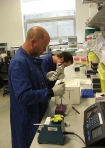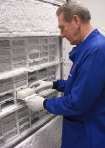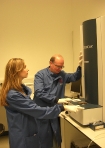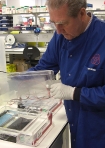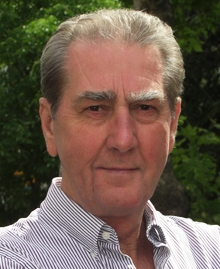 |
||
In order to follow genes and to examine their possible contributions to human behaviours such as musical ability or extroversion, we first have to find groups of suitable individuals and persuade them to allow us to sample their DNA. In the past, DNA was usually extracted from blood but some individuals are not keen to have blood taken for this purpose. More recently, however, our laboratory has developed a more “user-friendly” approach - used in this study - in which a few cotton buds are used to wipe the inside of the cheeks to collect cellular material. The swabs are then placed in a stabilising liquid that enables the sample to be safely transported by post or by other means to the laboratory. On arrival, the liquid is separated from the buds, heated to activate the protein degrading agent present and the DNA subsequently extracted (figure 1) and purified by precipitation using alcohol. The DNA is then stored at -80 degrees (figure 2).
We have written elsewhere about the most common type of difference between the genome of one person and another, the single nucleotide polymorphism (SNP). An SNP is a particular point in the DNA sequence that makes up the genome, where some people have one base and the rest have another – the two alternative forms being known as alleles. An individual may possess both alleles, inheriting a different one from each parent. There are many techniques that can be employed to detect specific SNPs and determine which individual has which alleles. Recent sophisticated methods can analyse up to ten million SNPs at one time; but these require complex equipment and are expensive. To compare the DNA of choral singers with non-musicians, we selected just a few critical SNPs - a common strategy in genetic studies. We chose them because they occur in genes already thought to be involved in performance and/or musical ability - the arginine vasopressin receptor 1a gene (AVPR1a) and a serotonin transporter gene (SLC6A4). Both are concerned with chemical transmission of nerve impulses in the brain.
We use a rapid procedure that can scan DNA samples from a batch of 380 individuals in a few minutes. Each sample is exposed to substances called “primers”, specifically designed to bind to the DNA sequences close to the SNPs which interest us. A huge number of copies of the small, defined region containing each SNP is then created (or amplified) using a process known as the polymerase chain reaction or PCR.
For each SNP, the two strands of the copied region are then separated and exposed to two different, very short, "purpose-built" single-stranded DNA segments known as probes. Both probes are designed to include a base sequence matching the DNA sequence around the SNP in the sample. However, at the SNP itself, the sequence of each probe is designed to match one allele only - the other probe matching the other allele. The probes also bear a fluorescent markers that differ from each other. In each person's sample, we establish which of the two probes is bound to the sample DNA by stimulating this marker. The wavelength emitted by the marker is detected by an appropriate camera and identifies which of the two probes is bound to the sample. The whole process is known as genotyping (figure 3).
As we have said, individuals possess two copies of each gene, one inherited from each parent. At each SNP, then, an individual may have the same allele from each parent - in which case he/she is termed a homozygote with respect to that SNP. Only the probe specific for the relevant allele will bind to the sample, so light of only one wavelength will be detected. Heterozygotes have inherited a different allele from each parent. Their samples will bind both probes and emit light of two different wavelengths.
Another common type of genetic difference between individuals is called a variable number tandem repeat (VNTR). There are more than a million VNTRS across the human genome and one of those we studied was central to the musical composition of “Allele”. VNTRs can vary from a single reiterated base to repeating motifs encompassing many hundreds of bases.
We examined five VNTRs within, or adjacent to, our two genes of interest, AVPR1a and SLC6A4. In this sort of genetic test, PCR is used to isolate and amplify a DNA sequence spanning each repeat section of interest. The length of each fragment isolated in this way is determined by the number of copies of the repeat it contains. During amplification, each fragment is tagged with a single fluorescent marker.
We then place the fragments from each sample on a gel bearing a negative electrode at one end and a positive electrode at the other. DNA carries an overall negative electrical charge and when electrical current is applied, the fragments are attracted to the positive electrode and move towards it in the gel. This technique is called gel electrophoresis (figure 4). Longer fragments are heavier than shorter ones and at any given time, they tend to have moved less far in the gel. Using the camera described above, the length of fragments in each sample can be deduced from the distance they travel on the gel. In each case, this distance is compared to the distance travelled by a selection of fragments of known length (figure 5).
In a group of individuals, there are usually only two possible alleles at an SNP. There may be many different possible alleles at a VNTR, depending on the number of repeats. At the RS3 VNTR in the AVPR1a gene, used in "Allele", the repeated motif is only two bases long. In our 500 samples, we found 15 different RS3 allele lengths, ranging from 320 to 352 bases. This being the case, it is unsurprising that samples from most individuals revealed two different fragment lengths on gel electrophoresis, i.e. most individuals are heterozygotes at RS3.
The two VNTRs associated with serotonin transporter gene were more complex than RS3. Particularly interesting was the 17 base repeat referred to as STin2. In keeping studies by other groups, we found three different principal alleles at this VNTR - with 9, 10 or 12 copies of the repeat motif. Our preliminary findings have suggested that the choral singer group have significantly more of the 12- and 9-repeat alleles, and fewer of the 10-repeat alleles, than have our non-musicians
Professor Ian Craig
![]()
